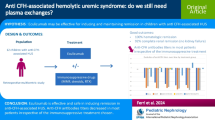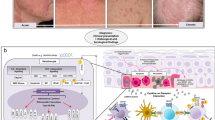Abstract
ANCA-associated vasculitis (AAV) is a life-threatening disease characterized by small vessel inflammation and pathogenic self-directed antibodies. Programmed death-ligand 1 receptor (PD-1) and programmed cell death ligand-1 (PD-L1) are immune checkpoint molecules crucial for maintaining tolerance and immune homeostasis. After checkpoint inhibition therapy, development of various autoimmune diseases and immune-related adverse events (irAEs) have been observed. Here, we investigated the immunomodulatory roles of neutrophils through the expression of immune checkpoint molecule (PD-L1), migratory molecules (CXCR2), chemotactic chemokines (CXCL5) and other important molecules (BAFF and HMGB1) in development of AAV. We also scrutinized the immune mechanism responsible for development of pauci-immune crescentic GN (PICGN). We demonstrate for the first time that the frequency of PD-L1 expressing neutrophils was significantly reduced in AAV patients compared to healthy controls and correlated negatively with disease severity (BVASv3). Further, in renal biopsy, reduced PD-L1 immune checkpoint expression provides a microenvironment that unleashes uncontrolled activated CD4 + T cells, B cells, neutrophils and macrophages and ultimately causes engulfment of immune complexes leading to PICGN. Furthermore, during remission, reduced neutrophils PD-L1 and CXCR2 expression, increased neutrophils CXCL5 expression and increased peripheral effector memory T cells and increased HMGB1 and BAFF levels in serum, demonstrate the propensity for the persistence of sub-clinical inflammation, which could explain relapse, in this group of diseases.





Similar content being viewed by others
Availability of data and materials
The datasets used and/or analysed during the current study are available from the corresponding author on reasonable request.
References
Jennette JC, Falk RJ, Andrassy K, et al. Nomenclature of systemic vasculitides. Arthritis Rheum Off J Am Coll Rheumatol. 1994;37(2):187–92.
Falk RJ, Jennette JC. ANCA disease: where is this field heading? J Am Soc Nephrol. 2010;21(5):745–52.
Jennette JC, Falk RJ, Bacon PA, et al. 2012 revised International Chapel Hill Consensus Conference Nomenclature of Vasculitides. Arthritis Rheum. 2013;65(1):1–11.
Ibañez-Vega J, Vilchez C, Jimenez K, Guevara C, Burgos PI, Naves R. Cellular and molecular regulation of the programmed death-1/programmed death ligand system and its role in multiple sclerosis and other autoimmune diseases. J Autoimmun [Internet]. 2021;123: 102702.
Juneja VR, McGuire KA, Manguso RT, et al. PD-L1 on tumor cells is sufficient for immune evasion in immunogenic tumors and inhibits CD8 T cell cytotoxicity. J Exp Med. 2017;214(4):895–904.
Qin W, Hu L, Zhang X, et al. The diverse function of PD-1/PD-L pathway beyond cancer. Front Immunol. 2019;10:2298.
Stamatouli AM, Quandt Z, Perdigoto AL, et al. Collateral damage: insulin-dependent diabetes induced with checkpoint inhibitors. Diabetes. 2018;67(8):1471–80.
Yoneda S, Imagawa A, Hosokawa Y, et al. T-lymphocyte infiltration to islets in the pancreas of a patient who developed type 1 diabetes after administration of immune checkpoint inhibitors. Diabetes Care. 2019;42(7):e116–8.
van den Brom RRH, Abdulahad WH, Rutgers A, et al. Rapid granulomatosis with polyangiitis induced by immune checkpoint inhibition. Rheumatology. 2016;55:1143–5.
Roger A, Groh M, Lorillon G, et al. Eosinophilic granulomatosis with polyangiitis (Churg-Strauss) induced by immune checkpoint inhibitors. Ann Rheum Dis. 2019;78(8):e82–e82.
Gallan AJ, Alexander E, Reid P, Kutuby F, Chang A, Henriksen KJ. Renal vasculitis and pauci-immune glomerulonephritis associated with immune checkpoint inhibitors. Am J Kidney Dis. 2019;74(6):853–6.
Sibille A, Alfieri R, Malaise O, et al. Granulomatosis with polyangiitis in a patient on programmed death-1 inhibitor for advanced non-small-cell lung cancer. Front Oncol. 2019;9:478.
Mamlouk O, Lin JS, Abdelrahim M, et al. Checkpoint inhibitor-related renal vasculitis and use of rituximab. J Immunother cancer. 2020;8(2): e000750.
Nabel CS, Severgnini M, Hung YP, et al. Anti-PD-1 immunotherapy-induced flare of a known underlying relapsing vasculitis mimicking recurrent cancer. Oncologist. 2019;24(8):1013–21.
Lu DI, Ni Z, Liu X, et al. Beyond T cells: understanding the role of PD-1/PD-L1 in tumor-associated macrophages. J Immunol Res. 2019;2019:1919082.
Wang J-F, Li J-B, Zhao Y-J, et al. Up-regulation of programmed cell death 1 ligand 1 on neutrophils may be involved in sepsis-induced immunosuppression: an animal study and a prospective case-control study. Anesthesiology. 2015;122(4):852–63.
Luo Q, Huang Z, Ye J, et al. PD-L1-expressing neutrophils as a novel indicator to assess disease activity and severity of systemic lupus erythematosus. Arthritis Res Ther. 2016;18(1):1–11.
McNab FW, Berry MPR, Graham CM, et al. Programmed death ligand 1 is over-expressed by neutrophils in the blood of patients with active tuberculosis. Eur J Immunol. 2011;41(7):1941–7.
Bowers NL, Helton ES, Huijbregts RPH, Goepfert PA, Heath SL, Hel Z. Immune suppression by neutrophils in HIV-1 infection: role of PD-L1/PD-1 pathway. PLoS Pathog. 2014;10(3): e1003993.
Curran CS, Kopp JB. PD-1 immunobiology in glomerulonephritis and renal cell carcinoma. BMC Nephrol. 2021;22(1):1–19.
Anguiano L, Kain R, Anders H-J. The glomerular crescent: triggers, evolution, resolution, and implications for therapy. Curr Opin Nephrol Hypertens. 2020;29(3):302.
Singh J, Sharma A, Rani L, et al. Distinct HLA and non-HLA associations in different subtypes of ANCA-associated vasculitides in North India. Int J Rheum Dis. 2020;23(7):958–65.
Zhang S, Wang L, Li M, Zhang F, Zeng X. The PD-1/PD-L pathway in rheumatic diseases. J Formos Med Assoc. 2021;120(1):48–59.
Zhang H, Watanabe R, Berry GJ, et al. Immunoinhibitory checkpoint deficiency in medium and large vessel vasculitis. Proc Natl Acad Sci. 2017;114(6):E970–9.
Zeisbrich M, Chevalier N, Sehnert B, et al. CMTM6-deficient monocytes in ANCA-associated vasculitis fail to present the immune checkpoint PD-L1. Front Immunol. 2021;12: 673912.
Al Mushafi A, Ooi JD, Odobasic D. Crescentic Glomerulonephritis: Pathogenesis and Therapeutic Potential of Human Amniotic Stem Cells. Front Physiol. 2021;12: 724186.
Ernandez T, Mayadas TN. The Changing Landscape of Renal Inflammation. Trends Mol Med. 2016;22(2):151–63.
Soukou S, Huber S, Krebs CF. T cell plasticity in renal autoimmune disease. Cell Tissue Res. 2021;385(2):323–33.
Gan P-Y, Steinmetz OM, Tan DSY, et al. Th17 cells promote autoimmune anti-myeloperoxidase glomerulonephritis. J Am Soc Nephrol. 2010;21(6):925–31.
Disteldorf EM, Krebs CF, Paust H-J, et al. CXCL5 drives neutrophil recruitment in TH17-mediated GN. J Am Soc Nephrol. 2015;26(1):55–66.
Chen S, Crabill GA, Pritchard TS, et al. Mechanisms regulating PD-L1 expression on tumor and immune cells. J Immunother cancer. 2019;7(1):1–12.
Hartley G, Regan D, Guth A, Dow S. Regulation of PD-L1 expression on murine tumor-associated monocytes and macrophages by locally produced TNF-α. Cancer Immunol Immunother. 2017;66(4):523–35.
Tipping PG, Holdsworth SR. T cells in crescentic glomerulonephritis. J Am Soc Nephrol. 2006;17(5):1253–63.
Black LM, Lever JM, Agarwal A. Renal inflammation and fibrosis: a double-edged sword. J Histochem Cytochem. 2019;67(9):663–81.
Müller A, Krause B, Kerstein-Stähle A, et al. Granulomatous inflammation in ANCA-associated vasculitis. Int J Mol Sci. 2021;22(12):6474.
Mao Z, Zhang J, Shi Y, et al. CXCL5 promotes gastric cancer metastasis by inducing epithelial-mesenchymal transition and activating neutrophils. Oncogenesis. 2020;9(7):1–14.
Hu N, Westra J, Rutgers A, et al. Decreased CXCR1 and CXCR2 expression on neutrophils in anti-neutrophil cytoplasmic autoantibody-associated vasculitides potentially increases neutrophil adhesion and impairs migration. Arthritis Res Ther. 2011;13(6):R201.
Kreuzaler M, Rauch M, Salzer U, et al. Soluble BAFF levels inversely correlate with peripheral B cell numbers and the expression of BAFF receptors. J Immunol. 2012;188(1):497–503.
Pollard RPE, Abdulahad WH, Vissink A, et al. Serum levels of BAFF, but not APRIL, are increased after rituximab treatment in patients with primary Sjogren’s syndrome: data from a placebo-controlled clinical trial. Ann Rheum Dis. 2013;72(1):146–8.
Lilliebladh S, Johansson Å, Pettersson Å, Ohlsson S, Hellmark T. Phenotypic Characterization of Circulating CD4 + T Cells in ANCA-Associated Vasculitis. J Immunol Res. 2018;2018:1–12.
Berden AE, Jones RB, Erasmus DD, et al. Tubular lesions predict renal outcome in antineutrophil cytoplasmic antibody–associated glomerulonephritis after rituximab therapy. J Am Soc Nephrol. 2012;23(2):313–21.
Solimando AG, Ribatti D, Vacca A, et al. Targeting B-cell non Hodgkin lymphoma: New and old tricks. Leuk Res. 2016;42:93–104.
Smith RM, Jones RB, Specks U, Bond S, Nodale M, Aljayyousi R, et al. Rituximab as therapy to induce remission after relapse in ANCA-associated vasculitis. Ann Rheum Dis. 2020;79(9):1243–9.
Solimando AG, Vacca A, Dammacco F. Highlights in clinical medicine—Giant cell arteritis, polymyalgia rheumatica and Takayasu’s arteritis: pathogenic links and therapeutic implications. Clin Exp Med. 2021. https://doi.org/10.1007/s10238-021-00770-4.
Wang G, Hu P, Yang J, Shen G, Wu X. The effects of PDL-Ig on collagen-induced arthritis. Rheumatol Int. 2011;31(4):513–9.
Song M-Y, Hong C-P, Park SJ, et al. Protective effects of Fc-fused PD-L1 on two different animal models of colitis. Gut. 2015;64(2):260–71.
Reynolds J, Sando GS, Marsh OB, et al. Stimulation of the PD-1/PDL-1 T-cell co-inhibitory pathway is effective in treatment of experimental autoimmune glomerulonephritis. Nephrol Dial Transplant. 2012;27(4):1343–50.
Ding H, Wu X, Wu J, et al. Delivering PD-1 inhibitory signal concomitant with blocking ICOS co-stimulation suppresses lupus-like syndrome in autoimmune BXSB mice. Clin Immunol. 2006;118(2–3):258–67.
Acknowledgements
The manpower for this work was supported by the Indian Council of Medical Research (ICMR), New Delhi (Grant/Award no. 3/1/3/JRF-2015(2)/HRD).
Funding
This work was supported by Institutional Grant of PGIMER (Grant No. 71/2-Edu-16/142).
Author information
Authors and Affiliations
Contributions
JS executed the study, analysed the data, and wrote the manuscript. RWM designed and mentored the study, edited and corrected the manuscript. BS gave inputs, and played an active role in use of PCR-arrays for kidney biopsy gene expression. RN reported and provided the histopathological details of kidney biopsy. AS treated and managed the patients, and provided the clinical details of the patients. SJ helped in recruitment and patient treatment. SA contributed to execution and standardization of experiments, and helped in analysis of kidney biopsy gene expression data. MR treated the pauci-immune crescentic GN patients. SD treated patients of minimal change disease, lupus nephritis and pauci-immune crescentic GN. All authors approved the final version of the manuscript and concurred on its submission.
Corresponding author
Ethics declarations
Conflict of interest
The authors declare no conflicts of interest.
Consent to participate
All participants signed informed consent form for participation in the study.
Consent for publication
Not applicable.
Ethics approval
The present study was approved by the Ethics Committee of Postgraduate Institute of Medical Education and Research (PGIMER), Chandigarh (IEC approval no: INT/IEC/2016/2515), and was performed in compliance with the Helsinki Declaration.
Additional information
Publisher's Note
Springer Nature remains neutral with regard to jurisdictional claims in published maps and institutional affiliations.
Supplementary Information
Below is the link to the electronic supplementary material.
Rights and permissions
Springer Nature or its licensor holds exclusive rights to this article under a publishing agreement with the author(s) or other rightsholder(s); author self-archiving of the accepted manuscript version of this article is solely governed by the terms of such publishing agreement and applicable law.
About this article
Cite this article
Singh, J., Minz, R.W., Saikia, B. et al. Diminished PD-L1 regulation along with dysregulated T lymphocyte subsets and chemokine in ANCA-associated vasculitis. Clin Exp Med 23, 1801–1813 (2023). https://doi.org/10.1007/s10238-022-00908-y
Received:
Accepted:
Published:
Issue Date:
DOI: https://doi.org/10.1007/s10238-022-00908-y




